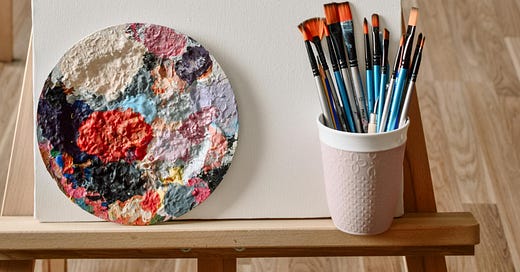The Palette of Life: How Colors Shape Mood, Music, and Meaning
Exploring the emotional power of color as a creative tool for artists, entrepreneurs, and everyday moments of celebration.
I write this oen from the road where you can experience an abundance of colors, if you know how to tap them. The other day, I was listening to a fascinating podcast about how interpreting colors could be used as a test for consciousness in AI. It delved into whether machines could truly feel the richness of color the way we humans do. As I listened, my mind started racing: beyond the technical implications, what about us as creatives and entrepreneurs? Colors aren’t just visual data—they’re powerful tools we use, often subconsciously, to express emotions, shape experiences, and tell stories. This realization pulled me into a colorful rabbit hole, and I want to take you along for the journey.
Colors and Mood: More Than Meets the Eye
It’s no secret that colors have a profound effect on our moods. Think about how the soft pastels of a sunset can calm you or how a room painted in bright yellow can energize—or even overwhelm—you. There’s a psychology to this. For example, blues are often associated with calmness and trust, reds with passion or urgency, and greens with growth and renewal. But the magic of color is that it doesn’t always mean the same thing to everyone. Personal experiences, cultural backgrounds, and even context can dramatically shift how we perceive them.
For creatives, this subjectivity is both a challenge and an opportunity. We can intentionally use colors to evoke specific feelings in our audience, but we can also leave room for interpretation, letting the viewer’s personal connection complete the story.
The Role of Color in Music and Performance
In music, color is often metaphorical but no less powerful. Have you ever heard a song described as “warm” or “cold”? Artists and performers use lighting design to create a mood for a show—a wash of deep blues for introspection, fiery reds for high-energy moments, or golds for nostalgia. The synesthetic link between sound and color even shows up in how we describe genres: jazz feels “blue,” punk feels “red,” and electronic music might lean “neon.”
As a musician myself, I’ve found that color imagery can help guide not just how we present our music but also how we write it. Thinking of a melody as “bright orange” versus “smoky gray” can shift the emotional direction of the piece entirely. Color becomes an unseen collaborator in the creative process.
Color as a Business Tool
Businesses have long understood the importance of color in shaping customer perception. The food industry is a prime example. Ever notice how fast-food chains favor red and yellow in their branding? Those colors are linked to hunger and speed—exactly the emotions they want you to feel. Meanwhile, upscale restaurants might use deeper tones like burgundy or emerald green to convey sophistication and leisure.
As entrepreneurs, we can harness these same principles when crafting our own brands. Your choice of logo color, website palette, or even packaging can subtly shape how your audience feels about your work. Whether you’re selling a craft beer, designing an album cover, or curating a boutique, the right colors can evoke trust, excitement, or curiosity.
The Interpretive Power of Color
What makes color so intriguing is its openness to interpretation. It’s both deeply personal and widely communicative. I might see blue as calm and reliable, but for you, it could bring memories of a turbulent ocean. In this way, color becomes a bridge between our internal and external worlds—a universal language with infinite dialects.
For creatives, this duality is invaluable. It reminds us that while we can guide the narrative with our color choices, the final interpretation is always in the hands (or eyes) of the viewer, listener, or customer. And that’s the beauty of it.
Conclusion: A Celebration of Color
Exploring color has reminded me how much of life is shaped by these subtle cues we often take for granted. Whether we’re creating art, running a business, or simply dressing for the day, colors are a tool we use to communicate, connect, and celebrate.
And so, as I reflect on all this, I’m reminded of something I hold close to my heart: EVERY day is a celebration. Whether it’s through the reds of passion, the greens of growth, or the blues of calm, let’s embrace the full spectrum life offers us.
Love,
Astro Joe Garcia
Bluebird Wine - Stoney Larue
Stoney LaRue’s “Bluebird Wine” is a vibrant ode to living in the moment, perfectly capturing the carefree and adventurous spirit of the Red Dirt music scene. Originally written by Rodney Crowell, LaRue’s rendition adds a raw, energetic edge that feels like a celebration of freedom and spontaneity. The “bluebird wine” serves as a metaphor for joy, creativity, and the sweetness of life’s small pleasures, set to a lively rhythm that inspires motion and connection. Much like the color blue can represent both vast skies and limitless possibilities, this song invites listeners to embrace the openness of life’s journey. It’s a reminder to seek out beauty and revel in the experience, making it an anthem for anyone chasing their passion or purpose.




